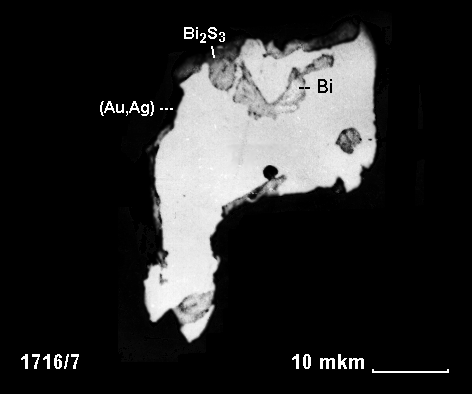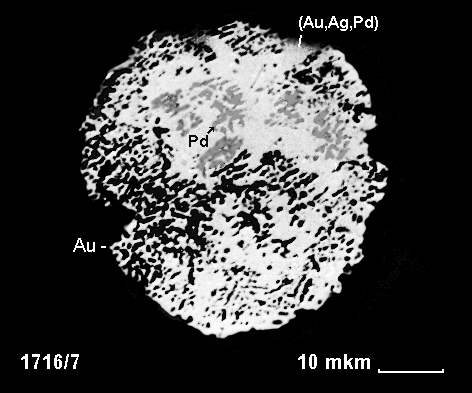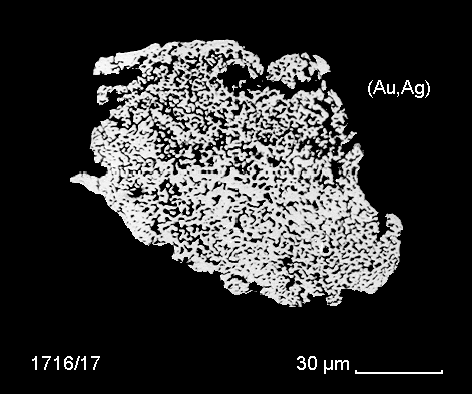PGMs in Zaonega black shale complex (Karelia)
Introduction
A new for Karelia-Kola region stratiformic type of noble metal mineralization in rocks of middle and upper members of Zaonega Early Proterozoic black shale complex is found in Onega depression (South Karelia). Two drill core samples of metapelites from depth 40 and 20m were studied from well 1716 in the north of Zaonega peninsula. The contents of noble metals in samples 1716/1 and 1716/7 (was processed by technology “ppm-mineralogy” more complete) is about: Au-0.09, Pd-0.06, Pt-0.03 ppm.
The well strips (aleuro-) pelites metamorphosed up to stages of epigenesis and aleuropelites have microlepidoblastic and granoblastic texture. The rocks are composed by quartz, albite, chlorite, white mica, epidote and organic matter. Sporadically occur microsegregations and microveinlets composed by minerals of more high temperature associations: magnesian biotite (hydrobiotite), chlorite of unstoichometric chemical composition, K and K-Na feldspars, actinolite, rutile. The rare grains of garnets of pyrope-almandine composition with inclusions of rutile, fibrolite (polymorph Al2SiO5) and diopside are identified. The identification of minerals with muscovite - chloritic and biotite - orthoclsic associations points to rather deep thermal transformation of primary sedimentary rock mass by processes of both metamorphogenic and metasomatic types.
Apart from pyrite, chalcopyrite, pyrrhotite, sphalerite, rutile, magnetite usually identified in studied rocks under microscope in artificial polished sections made from “heavy” concentrates as well by microprobe were identified monazite, wolframite, galenite, gersdorffite clausthalite, native bismuth, bismuthinite, bismite (Bi2O3) and minerals of noble metals. Minerals of noble metals and native bismuth as well as clausthalite were determined first time in blackshales, outside the ore deposits of the region under consideration. Bismuthinite and native bismuth form monomineral grains and intergrowths of two minerals as a rule by sizes less 0.1mm (photo 2). Bismuthinite quite often replaces the native bismuth and is spread in interstices and at grain boundaries. Intergrowths of bismuth minerals with pyrite, chalcopyrite and magnetite are revealed. Small clausthalite grains (<60µm) are usually monomineral. And are also met intergrowths of clausthalite with pyrrhotite. These minerals are often found in intergrowths with silicates of high temperature associations: biotite, garnet, K-Na feldspar and rutile.
|
Minerals. Back Scattered Electron Microscope Images
Clicking on images provides the higher resolution ones
|
||||
|
1
|
The grain of auricupride Cu3Au contains Ag and 0.3 wt. % of Pd.
|
|
2
|
Grain of Au with inclusions of native Bi and bismuthinite (Bi2S3).
|
|
3
|
Dark massive parts (1) inside the grain – tetra-auricupride (AuCu) with Ag and Pd. More light porous parts (2): high fineness gold: Ag 6-8%.
|
|
4
|
Polyphase grain: 1-tetra-aurocupride (AuCu), 2-native Pd (Au 9.2, Ag 1.6, Pd 83.3, Cu 5.4 Fe 0.7), 3-auricupride (Cu3Au), 4-gold (Ag 6.7%). High-fineness gold forms thin lace rim around the grain. In palladium phase the point with Pt 1.6% was noticed. (Full Image view is recommended).
|
|
5
|
Light massive parts of the grain – palladium gold with small-sized arranged inclusions of native Pd. Porous parts of grain – high- fineness gold. (Full Image view is recommended).
|
|
6
|
Porous spherical grain of high fineness gold.
|
|
7
|
Porous grain of high fineness gold.
|
|
8
|
Porous grain of high fineness gold.
|
Discussion
Examination of “heavy” concentrates (HC) of the assays has shown that the noble metal minerals are represented not only by native minerals of Au, Ag, Pd and Cu but by solid solutions and intermetallic compounds (intermettallides) of Au, Ag, Cu and Pd as well. Intergrowths of native gold with bismuth, bismuthitine and native bismuth are revealed (photo 2). Native palladium (photo 4 and 5) is always insight (in interstices) the grains of Au, Ag, Pd and Cu solid solutions in examined grains. The sizes of mono-mineral grains do not exceed 2µm. The grains of noble metal minerals measure from 20x30 up to 110x160µm. The shape of these grains is irregular with spherical outlines up to ball-shaped. It is clearly seen in polished sections that many grains throughout the volume are porous. The sinuous pores penetrate the grain partly or completely. Sizes of pores range from parts of micrometers to 2µm.
Solid solutions of Au, Ag, Cu and Pd (see photo 1-5) in examined rocks widely vary by chemical composition. Zoning of chemical composition of solid solution of Au, Ag, Pd and Cu is revealed in one of the grains. In the boundary part of the grain (photograph 4, points 1 and 3 accordingly) is observed enrichment of Au and Ag by Cu and Pd in comparison with the central part of the grain. This fact is compared to observed intercorrelation of solid solutions Au, Ag, Pd and Cu with separations of native palladium (photo 5 and 4, point 2). The process of evolution of chemical activity of noble minerals causing the formation of porous globular grains is also seen. The formation of porous more high- fineness parts in gold grains (globules) was accompanied by substraction of Ag, Cu or elimination of separations of native palladium with appearance of pores (photo 4). The final result of such process is the formation of thin porous globules of high-fineness gold (photo 6, 7, 8). As an analogy to such unusual formation we can point to “round crystals” sometimes with microporous surface of hexagonal solid solutions of Os, Ru and Ir which are typical “bodies of dissolution” by Jernovsky [1].
The composition of grains of noble minerals are classified within the limits of several areas of arranging of solid solutions of pseudo-binary systems of Ag-Au and (Ag, Au, Pd) – Cu [2]: 1) Au3Ag, 2) auricupride (Au,Ag,Pd)3Cu, 3)tetra-auricupride (Au,Ag)Cu. Except that were revealed the single grains of palladium native gold and tens grains of high fineness “porous” native gold. Binary condition diagrams Au-Ag and Au-Cu [2] determine the following upper (!) temperature limits of arranging of identified intermetallic compounds (intermettallides): for Au3Ag 470-480°C, for AuCu 410°C and for Au3Cu 390°C. These data in view of aforesaid allow us to assume essential influence of imposed thermal processes at formation of noble metal mineralization. However we want to underline that the melting point of native bismuth 270°C. Native bismuth is correlated with gold phases but maximum values of temperature fixed by binary diagrams simply did not influence on shapes of bismuth grains.
The obtained petrolographic and mineralogical data demonstrate that despite of stratiformic type of noble metal mineralization the last one depens on thermal process which causes concentration redistribution of noble metals. Stratiformic character of mineralization only reflects the configuration of volume with increased porosity and deconsolidation of rocks whereby thermal solutions move. There is no way to identify the primary source of noble metals information with existing level of methamorphogenetic-metasomatic transformation: the source may be hypogene as well as sedimentary origin.
We should like to call attention to one more detail the significance of which is not clear to us: as soon as we see noble metal mineralization in Archean or Proterozoic complexes of Karelia or Finland we for sure find bismuth minerals (!). Is it occasionality or regularity? (See studies of this site on gold of Karelia, ophiolite PGM's of Outokumpu).
References
- Жерновский И.В. Kристалломорфология и внутреннее строение индивидов гексагональных Os-Ru-Ir твердых растворов из ультрамафитов.
- Автореф. канд. дисс. Л.:1990, 22с.2. Hовгородова М.И. Самородные металлы в гидротермальных рудах. М.:Hаука, 1983, 286с.








